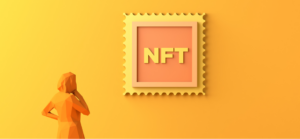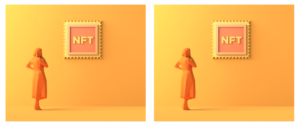29 Mar 22
This note is aimed at those of us whose initial reaction to NFTs is that they are a fad and the money pouring into the sector is creating a bubble. It’s the dot.com boom all over again.

For our generation “intangible” collectibles feel like an oxymoron. A collectible is something you can touch, feel and store in a shoe box. However, if it is a bubble, it’s a pretty big one. Companies in blockchain, crypto currency and NFTs are, according to Nielsen, predicted to be spending US$5bn on sports sponsorship by 2026. Last year saw many sector announcements, headlined by the $700M sponsorship of the Staples Centre by crypto.com. Again, according to Nielsen, 2022 is predicted to see an extraordinary eight-fold increase in the sector’s investment in sport as these companies scramble for legitimacy and fan engagement tools.

So, what is an NFT?
On the off chance we are wrong and NFTs are a game changing new element of a sports rights owners’ inventory, we should at least try and understand them. With that in mind, here’s a short guide aimed at the “older” reader. As a lawyer penned blog, it starts with some definitions:
- Non-Fungible – If something is non fungible it is not immediately interchangeable – it is unique. Just like no two match tickets are the same – each ticket relates to a specific seat in a stadium, for a specific game, on a specific day. Contrast this with something that is fungible – such as Bitcoin – if you and I exchange one bitcoin, we both still have the same thing. If we exchange NFTs we will each get something different.
- NFT – A Non-Fungible Token represents a unique identification, code and piece of metadata that differentiates it from any other digital asset. The NFT is comparable to a receipt, which can be used to represent “ownership” for the underlying asset. The difference is that receipt isn’t handed to you on a piece of paper, but instead stored as code on the blockchain.
- Blockchain – This is the underpinning technology that supports NFTs (and cryptocurrencies generally). The best way to think of a blockchain is a digital database that records information on digital transactions organised into linked “blocks” in the “chain”. The beauty of it is that as each block is a unique link in the chain, you can’t modify or interfere with one link without affecting the whole chain. As such it’s secure and reliable. The most common blockchain used for NFTs is the Ethereum blockchain.
- Minting – The process by which your asset becomes a certified/link to a blockchain.
Establishing that NFTs are a unique piece of code forming part of the blockchain is probably not taking us much further forward. Therefore, it is helpful to think about what an NFT is not. It is not one and the same as the underlying asset. When a purchaser buys an NFT of LeBron James’ slam dunk they are not buying the highlight clip itself, nor (in most cases) acquiring any intellectual property rights in that clip. It is nothing more than the purchase of some unique coding. However, that coding equates to a certificate of authenticity or a receipt proving your ownership of something unique linked to that LeBron clip. It works in much the same way as limited edition prints where the reputation of the artist, their signature and their scarcity all act to increase value.
The key is that this piece of code can create a unique link to all manner of valuable assets. This unique link is the token itself. The asset it links to can be anything, sporting highlights, iconic images, artwork, tweets, music clips, magazine covers or logos. The NFT grants ownership of that unique link to the digital asset which can, among other things, then be collected, displayed in a virtual gallery and, of course, traded.
Smart Contracts
This is where the “smart contracts” come in. They are the terms and conditions upon which the rightsholder sells the NFT. The smart contract is embedded in the blockchain and describes the NFT, but it can also be programmed to execute certain actions. In particular it can set out financial terms for primary and secondary sales or even royalties and automate these payments. It can also include rights to tangible benefits packaged up with the NFT. The options are limitless but can include tickets, preferential access, player meet and greets and personalised merchandise.
Rights Issues
As there is usually no transfer of the underlying asset, crucially the sale of the NFT does not involve the dilution of any existing rights. Banksy still retains the copyright in his artwork, Wimbledon still own their archive footage, and Liverpool FC still own their trademarks. The rightsholder may, as discussed, decide to package some rights or benefits up with the NFTs to enhance their value, but they aren’t obliged to. They can also place limits on the use of the NFT. For example, Alibaba used provisions in their smart contracts to issue NFTs for the Winter Olympics with a prohibition on trading them.
NFTs really are an opportunity for rightsholders to generate new revenues without creating new products. The process begins with the minting of the NFT. A rightsholder decides upon the assets from which it wants to create NFTs. The NFT is then minted via the creation of a unique piece of code identifying the asset and securing it on the blockchain. It usually includes a URL taking the purchaser to the server where the NFT or underlying asset is stored and accessed by the purchaser. Once minted the NFT can be sold on an online marketplace (such as OpenSea or Nifty Gateway), although it is also possible to arrange offline sales.
Value Proposition
So, who is going to pay serious money for a piece of code that links to something that just sits on your computer? Well Christie’s have been selling “objects of value” for over 250 years. They are masters at spotting and creating a market and expert valuers. They began selling NFTs in 2020 and sold Beeple’s NFT entitled “Everydays: The First 5000 Days” for US $69 Million. This seems to take the value principle of “it’s worth what people will pay” to an extreme. However, Beeple is now a globally renown digital artist and other NFTs he has minted have subsequently traded at many multiples of their drop price. Cricketer Steve Smith’s recent debut collection demonstrates some very different opinions on value. The Aussie media have ridiculed the idea of paying thousands of dollars for a “digital photo” of Smith looking moody and pensive. At the same time an army of Indian cricket fans are bidding and potentially driving subsequent drops above the $2500 currently being charged.
Value is of course driven by demand and a vast marketplace certainly helps. For those of us trading panini stickers or classic comics in the 1980s, the marketplace was rarely more than a school playground. The marketplace for NFTs is vast and the only boundary is connection to the internet.
Rightsholders can marry this vast marketplace with appealing underlying assets backed up by their credibility and reputation. The first generation of successful sporting NFTs have been based on iconic clips and images. Their popularity does not appear to be waning but more sophisticated rightsholders are already looking at more integrated NFT strategies. This can include:
- Ticketing. Given the security of the blockchain, NFTs can be a useful ticketing tool to prevent scalping and fraud. They can grant admission to a physical or virtual event, along with preview or post-event content. The ticket, as with all NFTs, can also be a collectible, gaining value over time for fans (albeit without the original access)
- Trading Cards. As playground bartering over sticker albums is consigned to history, the digital equivalent is growing at a rapid rate UFC, LaLiga, and the Premier League are all investing
- Fan Engagement, Voting and Ownership. Blockchain technology could revolutionise fan ownership, providing communities of fans holding NFTs with the ability to influence team governance, selection and even league rules
As always rightsholders need a critical mass of interested consumers for their sport to prosper. As consumers of live sport are a dangerously aging demographic, NFTs could form part of strategies to capture the attention of younger and more easily distracted fans. Fans who spend as much time designing their bedroom on Minecraft and displaying their NFTs in virtual galleries as other generations spent organising their Star Wars figures.

